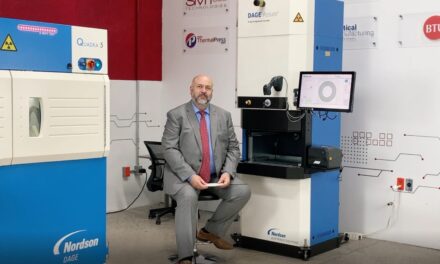Preparing Your Business for the Bipartisan Infrastructure Law and Beyond
By Kunlun Ouyang, Product and Industry Marketing Director, Bright Machines

The IIJA will tackle everything from supply chain issues to the climate crisis and is intended to give the U.S. economy a much-needed boost. Written into the law are improvements to ports, railways, airports, and roads, and dedicated funding to build out a national network of electric vehicle (EV) chargers as well as a clean energy transmission and grid.[1]
IIJA not only stands to improve the efficiency and safety of transporting goods and people across the country, but the law could also be a catalyst for the digital transformation of the industrial sector. Recent research from wealth management firm William Blair indicates that this law can help ensure that intelligent automation replaces dangerous, lower-skilled work and enable productivity growth over the next several years. Annual productivity in the United States could increase to 3%-4%, from the +/-2% seen over the past decade, while inflation could be mitigated and living standards could be improved.[2]
IIJA can also accelerate digital transformation by incentivizing companies to adopt modern technologies that meet the heightened demand for the domestic materials, equipment, and tools required to rebuild and upgrade America’s infrastructure. As we continue to move past the pandemic, this law has the potential to supercharge the recovery of our economy, our businesses, and our communities.
Acceleration of domestic production
As IIJA initiatives start to take off, sourcing American-made products will not only be a strong preference. The law will enforce domestic content requirements and expand domestic preference procurement policies, per the “Build America, Buy America” (BABA) section of the law. BABA funds will only be made available for infrastructure projects in which all the iron, steel, and manufactured products used are entirely produced in the United States.[3]
Take the $7.5 billion investment to build out a national network of EV chargers as an example; the Department of Transportation and the Department of Energy are working directly with U.S. manufacturers and automakers to ensure the network can be built in America and are coordinating with U.S. companies to understand what domestic sourcing is available today and what it could be in the future.[4]
In addition to the BABA requirements, the materials, tools, and components needed for IIJA projects must be readily available to avoid costly delays. Given the current supply chain challenges that have swept the world – from record-breaking shipping container backlogs to the high truck driver turnover – localizing physical production from a logistical standpoint will be essential.
Moving production closer to home (i.e., reshoring manufacturing) means companies need to produce materials, components, or products closer to where they are consumed. Business leaders are increasingly taking notice of the benefits of doing so. A survey of global analysts found that about 75% of companies are planning to accelerate their reshoring initiatives by building smart factories closer to home locations or their customers’ point of need.[5] That shift would help to minimize future disruption and allows organizations to overcome many of the risks associated with a global supply chain.
Intelligent automation will be vital
U.S. manufacturers, especially original equipment manufacturers of construction tools and industrial equipment, will need to ramp up their operations to meet the increased demand that will come with many IIJA initiatives.
Those who embrace modern technology and implement intelligent automation will have the edge over their competitors by securing new contracts earlier, delivering orders faster, and ultimately realizing operational improvements that will benefit them well beyond IIJA projects, including:
- Improved productivity: Modern technology solutions like intelligent automation help businesses improve asset and labor productivity by optimizing processes usually handled through time-intensive or highly repetitive manual work. This boost in productivity will be essential for meeting the anticipated increase in orders from IIJA initiatives. In addition, a full-stack approach to intelligent automation simplifies how manufacturers access and manage production data, which is the quickest way for them to improve equipment uptime and optimize production efficiencies. The numbers don’t lie – businesses that run smart factory initiatives have seen a 10% increase on average in production output and a 12% increase in labor productivity.[6]
- Quicker deployments and expansions: Intelligent automation enables manufacturers to deploy production lines faster through the rapid configuration of smart machines and operations. Within existing facilities, manufacturers can quickly scale to meet new demand levels by replicating the line with a “copy exact” method enabled by the full-stack approach. As a result, manufacturers gain the ability to deploy the same process from line to line, no matter how many lines are added. This method will also be essential when manufacturers need to quickly meet demand in regions where they may have minimal to no pre-existing presence, as successful lines can be deployed exactly as they are in existing locations. As companies invest in their factories to support IIJA projects, this method allows manufacturers to minimize downtime and start-up costs as much as possible while being nimble with capital investments.
- Enhance value of labor: Beyond producing more products at a lower cost, intelligent automation can make better use of people currently in the factory while helping attract new workers. For example, within a factory, a line manager can now expect to be alerted of a potential quality issue before it happens and conduct preventative maintenance to avoid the problem, reduce overall scrap material and waste, and ensure a quality product for the end-consumer.
Additionally, as today’s workers are often more interested in performing jobs typically not found on a manual assembly line, cutting-edge technology makes room for more desirable, innovative careers that use robotics, machine learning, and artificial intelligence. Introducing these technologies into manufacturing will help attract top talent in a heated job market. The continual improvement in performance and the offering of exciting careers go hand in hand.
The manufacturing sector will experience unparalleled growth over the next five to ten years as the IIJA shifts from legislation to fulfillment. The organizations that move operations closer to home, transform production with intelligent automation, and embrace these new infrastructure initiatives are the ones that will be set up for success both today and in the future.













